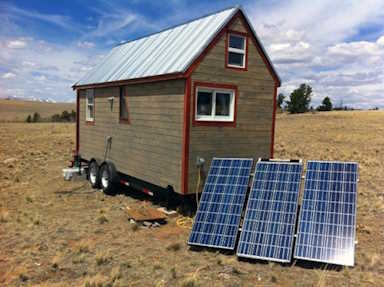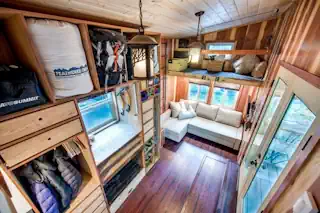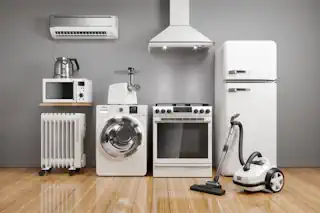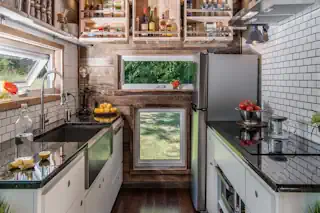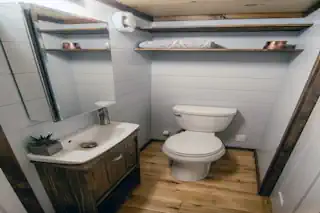Navigating Waste Management in Tiny House Living: The Complete Guide to Sewer Systems

Exploring the terrain of sustainable living leads many to the charm and practicality of tiny home living. Within the confines of efficient, compact design, every element is crucial, and none more so perhaps, than the sewer system. For those committed to a lifestyle that minimizes environmental impact without compromising comfort, the choices made around waste management are pivotal. In this guide, we unlock the essentials of tiny home sewer systems, offering insights for every stage—from initial installation to forward-thinking tech and maintenance.
Why Sewage Solutions Matter in Tiny Home Living
Tiny homes aren’t just a passing trend; they embody a philosophy of simplified living and a reduction of material and environmental footprint. With limited space and a conscious choice for fewer, high-quality possessions, the presence of an efficient and unobtrusive sewage system underscores the essence of this way of life. Furthermore, as the movement’s root in sustainability deepens, the choice of a tiny home sewer system becomes a beacon of environmental ethic, an investment in the very landscape you’re aiming to preserve. Managing waste water is a significant part of water management in tiny houses.
The Core of Sewer Systems for Most Tiny Houses
Choosing the right sewage solution is critical in realizing a seamless functioning of your tiny home. Here, we will break down the types of systems that fit your space and needs, from the venerable composting toilet to more conventional options. Understanding the core components of each system is akin to knowing the engines in your cars—the tanks, the traps, the ventilation, and the drainage systems—each with vital roles to play. When selecting a system, factors such as regulatory requirements, energy autonomy, and the presence of an adequate waste treatment facility near you, if any, must weigh in.
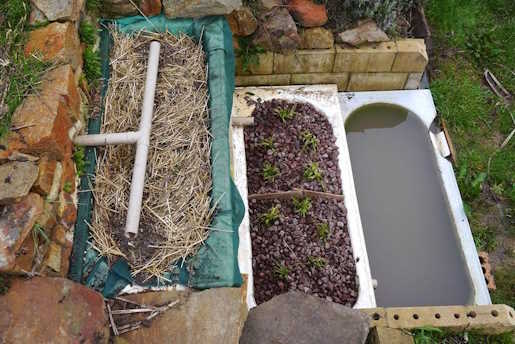
Top 10 Sewage Solutions for Tiny Homes
Composting Toilets: A fan favorite for their minimal water usage and simplicity, composting toilets convert human waste into compost that can be safely added to gardens.
Dry Toilets: Requiring no water, dry toilets use a bagging system for waste collection, making them another eco-friendly option.
Incinerating Toilets: These burn waste into a small amount of ash, eliminating pathogens and reducing waste volume significantly.
Greywater Systems: Designed to reuse water from sinks and showers for irrigation, greywater systems highlight water conservation in tiny homes.
RV Holding Tanks: A practical choice for mobile tiny homes, offering a familiar system that’s easy to empty at designated dump stations.
Cassette Toilets: Compact and portable, cassette toilets are ideal for those on the move, with waste containers that can be manually emptied.
Chemical Toilets: Often seen in boats or RVs, chemical toilets use a deodorizing chemical to break down waste, suited for short-term use or travel.
Biological Digesters: A high-tech solution that uses bacteria to break down waste into water and carbon dioxide, requiring professional installation.
Sawdust Toilets: An off-grid favorite, sawdust toilets use a layer of sawdust after each use to control odor and encourage composting.
Solar Toilets: Utilizing solar power to treat waste, solar toilets offer an innovative, energy-efficient method that minimizes environmental impact.
Each of these solutions presents a unique set of benefits, tailored to different lifestyles and preferences within the tiny home community. Whether prioritizing sustainability, ease of use, or technological innovation, there’s a sewage solution that aligns with every tiny home dweller’s ethics and needs.
Each of these are portable solutions that do not include fixed solutions like water lines, septic tanks, city sewer or city water supply sources. These are more common in a traditional house and can be added to your tiny house if you decide on a more permanent location. These are also solutions that do not require regular visits to a dumping station to drain a holding tank or fill a fresh water holding tank.
Sewage and Sustainability: Merging Efficiency with Eco-Friendliness
Sustainability and tiny home living are synonymous, and your choice of a sewer system should reflect that deeply. We’ll discuss options that breathe sustainability into your home’s waste management, focusing on water conservation and innovative technologies that reduce, reuse, and recycle. This is the section where forward-thinking options such as greywater recycling and aerobic treatment units come into play, highlighting the cutting edge in eco-conscious sewage solutions.
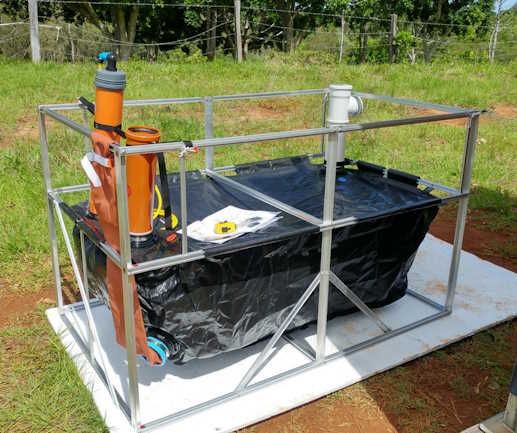
The Top 5 Most Eco-Friendly Sewer System Options for Tiny Homes
Composting Toilets: By transforming human waste into nutrient-rich compost, these toilets stand out for their zero-water usage and contribution to soil enrichment.
Greywater Systems: Capturing water from the kitchen sink, bathroom sink and showers to reuse in your garden marries water conservation with practical landscaping, making every drop count.
Solar Toilets: Harnessing the sun’s power to treat waste, solar toilets offer a revolutionary approach to waste management with minimal environmental footprint.
Biological Digesters: Leveraging natural processes, these systems use bacteria to break down sewage into harmless water and carbon dioxide, emphasizing the cycle of renewal.
Sawdust Toilets: Ideal for the truly off-grid lifestyle, sawdust toilets use a natural bulking material to facilitate composting, controlling odor and reducing waste without water use.
Each of these systems offers a pathway to sustainable living, reflecting the ethos of tiny home enthusiasts who are dedicated to minimizing their environmental impact while enjoying a life of simplicity and innovation.
DIY Sewer Systems for the Adventurous
For the hands-on homeowner, the notion of crafting your own sewer system from scratch can be incredibly rewarding and, ideally, cost-effective. However, the Do-It-Yourself path isn’t without its pitfalls. We’ll detail the level of expertise required, the tools you’ll need, and the pros and cons of DIY installation. If you’re thinking of rolling up your sleeves, ensure you’re well-informed and that you’ve got the right support and resources on hand.
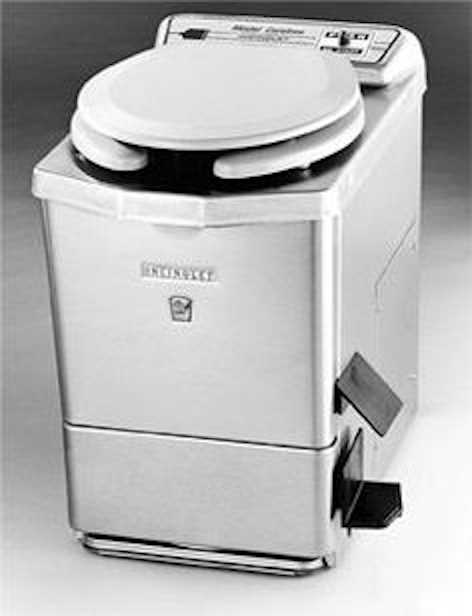
Top 5 DIY Sewer System Options for Tiny Homes
Basic Composting Toilet Systems: A DIY classic, you can create a simple composting toilet using everyday materials. This method requires regular maintenance but significantly reduces water usage and the need for water lines or drain lines.
Greywater Wetland: Construct a small-scale reed bed that filters greywater through plants and sand, a beautiful solution that also benefits your garden and avoids the costly install of a septic system.
Bucket and Sawdust Toilets: For the ultimate in simplicity, use a bucket with a toilet seat lid and sawdust after each use to cover waste and control odor. This requires regular composting outside.
Homemade Incinerating Toilet: Though complex, it’s possible to build an incinerating toilet that burns waste into ash. This option demands a solid understanding of safety and local regulations.
Drum + Sawdust Composting System: This involves a larger drum where waste is mixed with sawdust and turned regularly to aerate, speeding up the composting process. Ideal for those with a bit more space and commitment to composting.
Each DIY option offers a rewarding project for those willing to invest the time and energy, making your tiny home even more personal and eco-friendly. We never talk about these options in traditional houses but maybe we should make some of these items a standard part of all plumbing system designs.
Professional Installation: When to Call in the Experts
Sometimes, the assurance of a professional touch outweighs the appeal of DIY. In this section, we underscore the scenarios where professional installation is not only preferable but paramount. We’ll guide you through finding a reliable contractor, what to expect in terms of cost, and how to maintain a healthy relationship with the professional you choose. The peace of mind that comes with a job expertly done is often worth the investment.
Top 5 Advantages of Professional Installation of a Sewer System in a Tiny Home
Expertise and Reliability: Professionals bring an unparalleled level of expertise and know-how to the installation process, ensuring that your sewer system is set up correctly and operates efficiently from day one.
Saves Time: Having a professional handle the installation can save you considerable time, allowing you to focus on other aspects of living in or constructing your tiny home.
Compliance with Regulations: Professionals are well-versed in local building codes and environmental regulations, ensuring that your installation is compliant and that you avoid potential legal headaches down the line.
Long-Term Cost Efficiency: While DIY solutions may seem cost-effective initially, professional installations can ultimately be more economical due to higher quality work that minimizes the need for repairs and maintenance.
Peace of Mind: Knowing that your sewer system has been professionally installed provides peace of mind, allowing you to enjoy your tiny home without worrying about potential issues arising from improper setup.
Maintaining Your Tiny Home Sewer System
Once the system is in place, the work isn’t over—it’s just begun. Proper maintenance is the lifeline ensuring your system’s longevity and efficiency, and we go over the necessary tasks required. From the timing of waste releases to regular cleaning and troubleshooting, care of your system can make the difference between a peaceful existence and a quickly burgeoning problem.
Top 5 Maintenance Activities for a Tiny Home Sewer System
Regular Inspection and Cleaning: Ensure that your system, especially if it’s a composting, incinerating, or biological digester type, is inspected and cleaned periodically. This prevents build-up and ensures everything operates smoothly.
Compost Turning for Composting Systems: If you use a composting toilet, regularly turning the compost is crucial. This aerates the pile, helping it decompose properly and preventing odors.
Monitor and Manage Greywater Systems: For those with greywater systems in place, it’s important to monitor the output and ensure plants and sand filters are healthy and functioning. Replace or clean the filters as needed for optimal performance.
Emptying the System at Appropriate Intervals: Regardless of your sewer system type, it will need to be emptied or cleaned out at intervals. Ensure this is done regularly to prevent overflow or system failure.
Troubleshooting and Repair: Stay vigilant for signs of malfunction, such as unusual odors, slow decomposition, or system backups. Addressing these issues promptly can prevent more significant problems down the line.
By keeping up with these maintenance activities, you ensure that your tiny home sewer system remains a reliable and hygienic part of your sustainable living solution.
Anticipating the Future: Trends in Tiny Home Sewer Systems
The world of tiny home living—and by extension, its sewer systems—is an evolving one. In this futuristic section, we peer into upcoming technologies and innovative approaches that promise to redefine the very nature of waste management. Think smart sewage systems that communicate with your phone, or bio-inspired solutions that take their cues from natural biological processes. It’s an exciting realm and, in some ways, the final frontier for sustainable living in tiny spaces.
In Closing: The Heart of Tiny Living
In wrapping up our guide to tiny home sewer systems, it’s evident that sustainable living is more than just a trend—it’s a mindful approach toward a balanced relationship with our environment. Whether you opt for a DIY project or seek the expertise of professionals, the essence of tiny living is about making informed decisions that reflect a commitment to sustainability and efficiency. Remember, each small step toward sustainable waste management is a giant leap for the well-being of our planet. We invite you to continue exploring, innovating, and sharing your experiences. Together, as a community of tiny home enthusiasts, we pave the way for a greener, cleaner future.
Frequently Asked Questions (FAQs)
We understand that transitioning to or enhancing your tiny home’s sewer system can lead to many questions. Here are answers to some commonly asked questions we’ve received from our community:
Can I install a tiny house sewer system on my own, or do I absolutely need a professional?
While some aspects of the sewer system installation can be managed as DIY projects, we strongly recommend consulting with or hiring a professional for critical components, especially those involving the sewer line to ensure compliance with local regulations and to guarantee the system’s efficiency and safety.
How often should I perform maintenance on my tiny home sewer system?
The frequency of maintenance depends on the type of sewer system installed and its usage. However, a good practice is to conduct a thorough inspection and perform necessary maintenance tasks at least once every six months.
What is the most environmentally friendly sewer system for tiny houses?
Composting toilets are a great idea and are often lauded for their environmental benefits, as they use little to no water and convert waste into compost that can nourish the earth. However, the best system for you depends on your living situation, local regulations, and sustainability goals.
Can a tiny home sewer or septic system handle the same waste as a conventional home?
Yes, with the right design and maintenance, tiny home sewer systems can handle daily waste efficiently. The key is to choose a system that aligns with your household’s size and waste production.
What should I do if I encounter problems with my sewer system?
First, consult the troubleshooting section of your system’s instruction manual. If the issue persists, it’s wise to contact a professional as soon as possible to prevent further damage or inconvenience.
Remember, the tiny home community is vibrant and supportive. If your question hasn’t been answered here, don’t hesitate to reach out to fellow tiny home owners or professional installers for advice.

